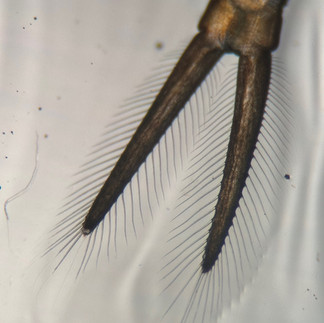Eubranchipus intricatus
- Irving P.

- Aug 15
- 2 min read
Updated: Aug 31
Taxonomy and Classification
• Phylum: Arthropoda
• Class: Branchiopoda
• Order: Anostraca
• Family: Chirocephalidae
• Genus: Eubranchipus
• Species: E. intricatus
• Authority: Hartland-Rowe, 1967
Eubranchipus intricatus, commonly known as the intricate fairy shrimp or smooth-lipped fairy shrimp, belongs to the order Anostraca and the family Chirocephalidae. This species is morphologically similar to E. bundyi and E. vernalis, but distinguishable by male antennal appendage structure and labrum morphology. First described by Hartland-Rowe in 1967, this species thrives in ephemeral freshwater habitats, particularly vernal pools and seasonal wetlands that form during cooler months. These pools are typically clear, cool to cold, with neutral to slightly acidic pH, and are often surrounded by vegetated landscapes such as prairies or forested areas.The distribution of E. intricatus is broad but sporadic, with populations documented across southeastern Canada (Alberta, Manitoba, Nova Scotia, Saskatchewan) and adjacent regions of the United States, including Massachusetts, Minnesota, Montana, Vermont, and Wyoming. A disjunct eastern population exists in Vermont and Massachusetts, where the species is considered rare and is protected under the Massachusetts Endangered Species Act as a Species of Special Concern.

The characteristics outlined below may exhibit variations influenced by environmental conditions, population dynamics, and the organism's age.
IDENTIFIABLE TRAITS OF THIS SPECIES
Male Second Antenna:
Eubranchipus is a Holarctic genus of fairy shrimp distinguished by a combination of sexually dimorphic traits and reproductive structures that facilitate species-level identification. Males exhibit prominent modifications of the second antennae, which are typically flattened, lobed, or paddle-like, and often bear distal expansions or setae used for clasping females during copulation. The frontal appendages, arising medially from the head, are generally bifurcated or branched, and vary in length and complexity across species, serving as additional diagnostic characters.
Female Brood Pouch:
Females are identified by the morphology of the brood pouch, which is ventrally located and may be elongate, sac-like, or lobed depending on the species. The lateral lobes flanking the brood pouch also vary in shape and ornamentation, contributing to interspecific differentiation. These reproductive structures are evolutionarily conserved and play a critical role in species recognition and mating compatibility.
Size: Adults reach 12–15 mm in length
Coloration: Reddish-yellow to orange, with extremities turning yellowish-white upon maturity
Head: Enlarged with stalked compound eyes
Thorax: Bears flattened, leaf-like phyllopodia for swimming and respiration
Abdomen: Long, ending in two distinct cercopods
Conservation Status
Listed as a Species of Special Concern under the Massachusetts Endangered Species Act
Also recognized as a Species of Greatest Conservation Need in the Massachusetts State Wildlife Action Plan
No federal protection status
Gallery:



















Comments